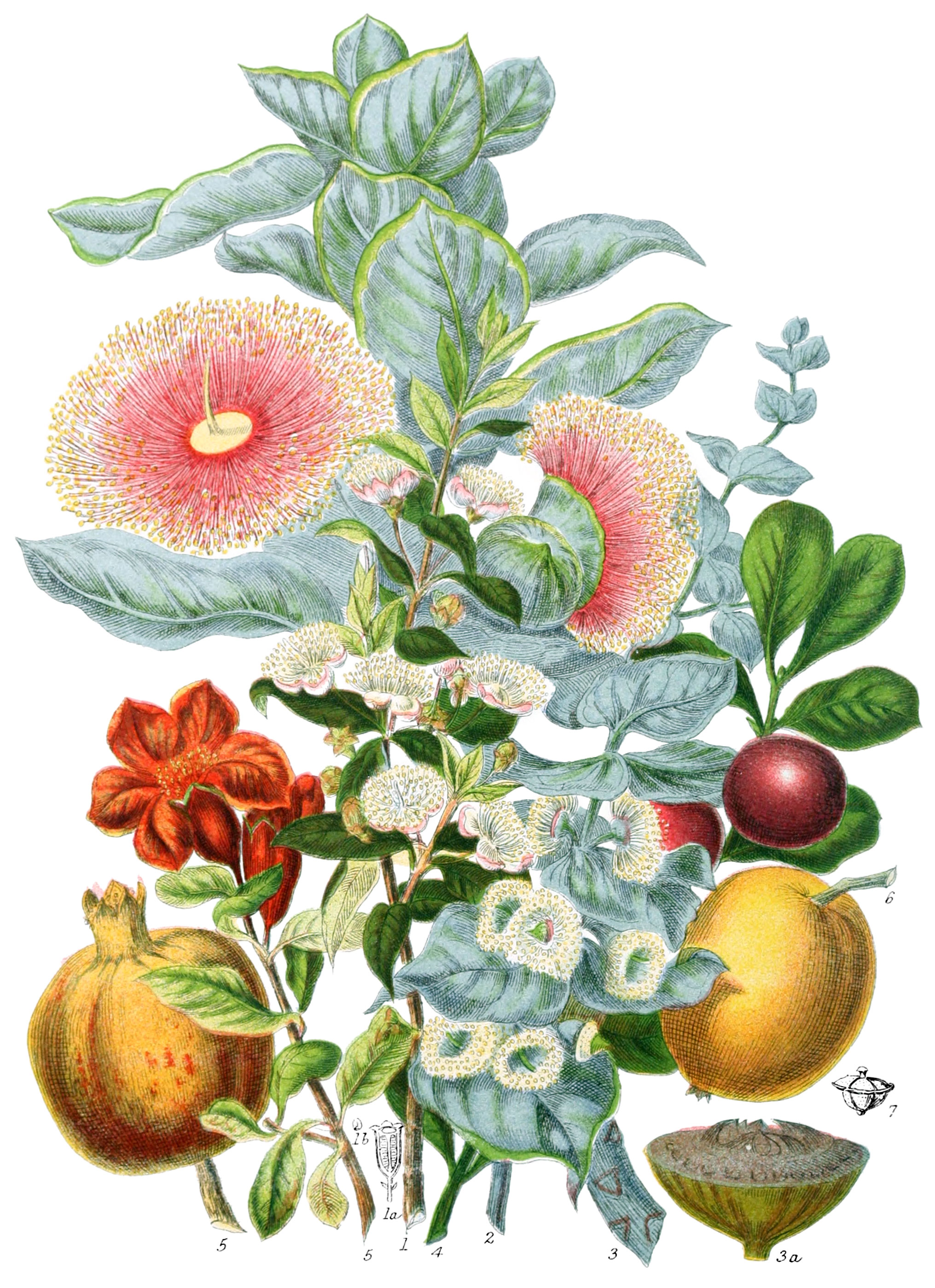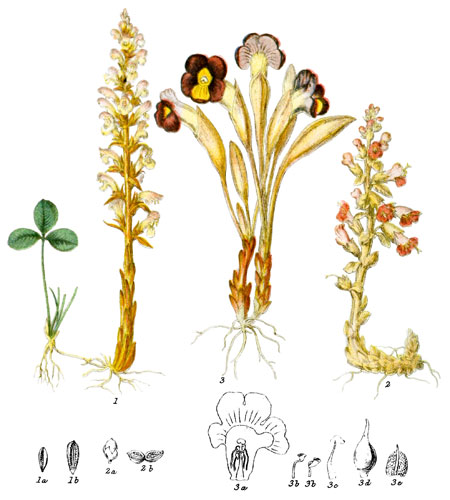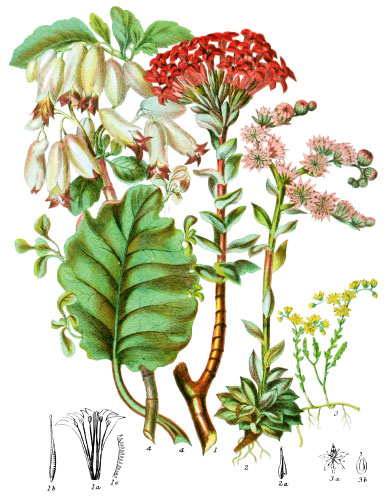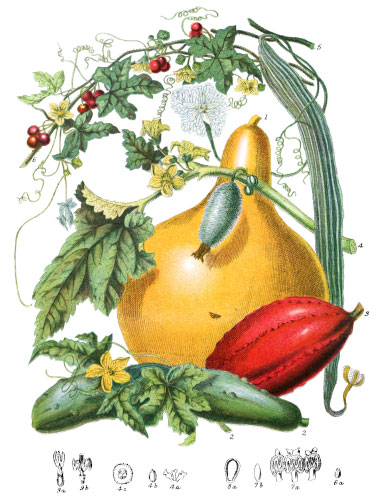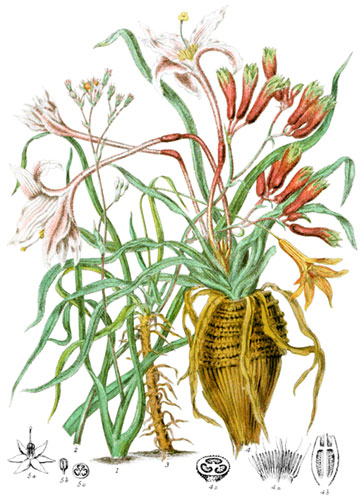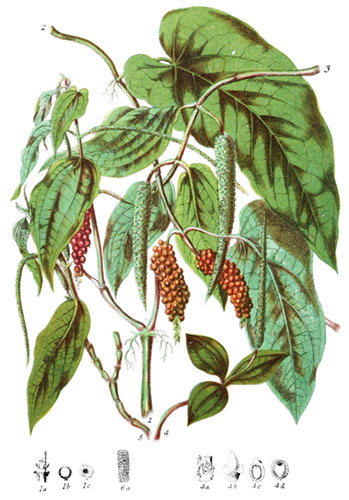Key characteristics
Trees and shrubs, no herbaceous plants. Leaves opposite, entire, usually having transparent dots, and a vein running parallel with the margin. The flowers are various in form, but grow usually from the base of the leafstalk; they are red, white, occasionally yellow, never blue. The calyx is adherent, four or five cleft at the top, sometimes cohering together at the points, and falling off like a cap, as in Eucalyptus. The petals are equal in number to the divisions of the calyx. Stamens either twice as many as the petals, or numerous, rarely of the same number; the filaments are distinct, or connected in several sets, curved inwards before flowering; the anthers are ovate, two-celled, opening lengthwise. The ovary is from one to six celled, the style simple. The fruit is either dry or fleshy, entire or gaping; the seeds are usually of indefinite number, and variable in form.
This is one of the most clearly defined of the natural orders of plants, and very easily recognized. The opposite leaves without stipules, with a smooth edge and marginal vein being sure indications of it. It is closely connected with Rosaceæ, Melastomaceæ, and others, but is obviously distinguishable from all. Nearly all are highly aromatic, from an oil contained in the pores of the leavs. Some curious transformations of petals and sepals occur in this tribe.
Select plants in this order
Not all plants listed are illustrated and not all plants illustrated are listed.
- Myrtus (1) was known to and named by the ancient Greeks, and retains the same derivation in all European languages. It was a celebrated plant in Athens, employed as a symbol of honour in victory, and of justice for judges, and dedicated to Venus on account of its beauty and aromatic fragrance. The berries were added to wine, used in cookery, and in medicine for their astringent properties. The buds are still eaten as pepper in Tuscany, and the bark is used for tanning. It was long ago brought to England, and now flourishes in the southern counties in great luxuriance, particularly on the coast, the air of the sea being remarkably favourable to it, as was observed anciently in Greece.
- M. tomentosa yields eatable berries on the Neilgherries.
- M. nummularia is the smallest plant of this tribe, spreading over the ground in the Falkland Isles.
- Eucalyptus pulverulenta (2) and E. macrocarpa (3) are examples of the Gum trees of Australia, where they rank amongst the loftiest timber trees; the stems of some species rising in a straight column to the height of 150 feet before branching; the foliage is of a singular grey hue, the same on both surface, forming a striking contrast with the bright glossy leaves of the European Myrtle. The flowers have no petals; the united calyx, being separated from the top of the cup by the force of the expanding stamens, falls off like a cap. A valuable kind of Tannin is prepared from the bark of several species, and is said to be much more powerful than that of Oak.
- E. resinifera of New South Wales yields an efficacious gum resin.
- E. mannifera exudes a sweet substance resembling Manna, in the dry season.
- E. robusta has cavities in the stem containing a fine red gum. Another species furnishes a copious juice which ferments like beer, and is considered a refreshing beverage by the inhabitants of Tasmania.
- The different kinds of Psidium, or Guava, afford a pleasnt fruit in the West Indies, that of P. Cattleyanum (4) is esteemed the best flavoured.
- The dark curled-grained wood of P. montanum is much valued for its ornamental uses.
- Punica is said by Pliny to have been so named from having been found growing abundantly on the shores of Carthage. It was early celebrated for the medicinal properties of the fruit in Persia, where it forms extensive woods. In Europe it is still employed medicinally; the fruit is considered delicious in the East.
- Eugenia was named after Prince Eugene of Savoy, a great patron of botany.
- E. Malaccensis (6) is much cultivated in the Malay Isles for the sake of its agreeable fruit, which has the fragrance of a rose; several species bearing eatable fruit grow in South America; Allspice is the dried fruit of E. Pimento.
- Leptospermum scoparium abounds on the shores of many parts of Australia and New Zealand, where it was found by Captain Cook; th eleaves, having a pleasant bitter flavour, were used by his crew as tea. The seed-vesel is of a remarkable vase shape (7).
- Nearly all species of Metrosideros are evergreen shrubs of Australia, where the hard wood is of much value.
- M. buxifolia, the aki of New Zealand, is a rambling shrub climbing by means of its side rootlets to the top of the highest forest trees in the Bay of Islands.
- Cajeput oil, valued for its stimulant properties, is distilled from the leaves of Melaleuca Cayaputi of the Moluccas.
- The dried flower-buds of Caryophyllus aromaticus are the spice Cloves.
Locations
The plants of this Tribe are dispersed in Tropical and other hot countries; a great number are natives of the East Indies and South America; in Chile, they grow to the height of 2000 feet on the Andes; at the Equator, the region of Myrtaceæ ascends to upwards of 5000 feet; many genera are peculiar to Australia and South Sea Isles. Sonneratia and Careya belong exclusively to India and its islands. Psidium and Eugenia are natives equally of Asia and America. Metrosideros augustifolia and a very few others are found in Africa; M. lucida extends as far south as Lord Auckland’s Isles. Myrtus is a widely dispersed genus, found at the Straits of Magellan, in Peru, and on the mountains of India. M. communis is the most northern species, having become naturalized in South Europe.
Legend
- Myrtus communis, Common Myrtle. Persia and S. Europe.
- Section of Ovary.
- Seed.
- Eucalyptus pulverulenta, Powdery Gum-tree. New Holland.
- Eucalyptus macroearpa. Swan River.
- Seed-vessel.
- Psidium Cattleyanum, Purple Guava. South America.
- Punica Granatum, Pomegranate. S. Europe.
- Eugenia Malaccensis, Malay Rose-apple. East Indies.
- Leptospermum scoparium, New Zealand Tea Plant. New Zealand.
Explore more
Posters
Decorate your walls with colorful detailed posters based on Elizabeth Twining’s beautiful two-volume set from 1868.
Puzzles
Challenge yourself or someone else to assemble a puzzle of all 160 botanical illustrations.
